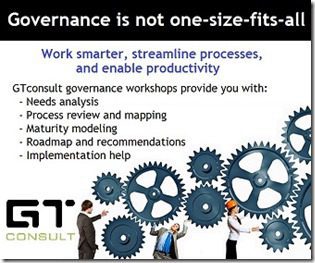Launching Governance Workshop “Jam Sessions”
For most organizations that rely on SharePoint to manage many of their business-critical workloads, governance continues to be a chief concern. As with most user-driven technologies, SharePoint is often unleashed without proper planning or governance structures, and most administrators find themselves needing to retroactively apply standards across their environment. Companies tend to hoard information and may find themselves overwhelmed by the disorganization and how to even begin the process to get things under control. Spend any time working with knowledge management and collaboration platforms, and you quickly understand that without proper management, search becomes ineffective, content become silos hidden behind team sites (or even within team sites), and user satisfaction plummets. Unfortunately, there is no easy button to fix this problem, and its not a problem unique to SharePoint. Even the most proactive organizations struggle from time to time with managing their system governance.
 The team at GTconsult has developed a framework for helping organizations “jumpstart” their governance efforts, and are now offering a series of workshops called “Jam Sessions” which include a detailed analysis of current policies and procedures, an assessment against our SharePoint governance maturity model, and recommendations for your roadmap and implementation (check out “Practical Governance: Administration of Your Platform” by our own Melinda Morales (@trulymelinda) for an example of what will be covered).
The team at GTconsult has developed a framework for helping organizations “jumpstart” their governance efforts, and are now offering a series of workshops called “Jam Sessions” which include a detailed analysis of current policies and procedures, an assessment against our SharePoint governance maturity model, and recommendations for your roadmap and implementation (check out “Practical Governance: Administration of Your Platform” by our own Melinda Morales (@trulymelinda) for an example of what will be covered).
These workshops are on-site and hands-on with our team of experts, with the goal of giving your administrative team the knowledge and tools to keep SharePoint running efficiently, and ensuring your end users are productive. Whether you already have a governance plan developed and just need an expert review and recommendations, or you need help in identifying your requirements and completely overhauling your system, these workshops can help. To request more information, or to book a Jam Session, contact us here.
What can you do in the meantime to prepare?
- Learn from others. I highly recommend that you take a look at the presentation SharePoint Governance from the Trenches: Sony Electronics Case Study to learn more about how this huge enterprise organically built out their own governance model through trial and error.
- Outline your plan. Develop a “wish list” of reports and requirements based on your organizational and project needs, and any legal or regulatory requirements. Help your management team and end users to understand the full scope of the project – that it’s not just about a technical implementation, but that it is also a business process change.
- Create an internal SharePoint user group. Even if your plan is to release a tightly-controlled portal with strict guidelines around content types, workflow, and usage, you still need to involve the users and get their perspective. The power of SharePoint is its ability to inspire collaboration, even within a meticulously choreographed user experience. You need to tap into the community as a way to refine your model, adapt your systems to the ebb and flow of the business, and, quite simply, to learn from your users.
- Clearly define roles and responsibilities. Farm Administrators. Site Administrators. Project Owners. Approvers. Reviewers. Identifying core permissions and groups within SharePoint is key. While at Microsoft, I was a fan of the OARP model: Owner, Approver, Reviewer, Participant. It was simple and clear (when it was used). At the very least, you should understand roles within your organization so that it is evident where accountability resides.
- Understand any regulatory or compliance concerns. Are there any rules or procedures having to do with legal or financial guidelines that may dictate how you setup and/or manage your SharePoint environment? Do you need to maintain audit trails? Reporting? Workflows? Metrics? These items would fall into the scoping and sizing of your project during the planning phase.
- Outline your information architecture and governance policies. This is the most difficult aspect of governance for most organizations: putting pen to paper and outlining the rules and constraints of your system. Most organizations already have corporate and IT governance standards in place, or have a collection of industry or regulatory requirements that will define the constraints of your governance strategy. Sit down with your governance task force with a fixed amount of time (an hour) and create a high-level draft. Then publish the draft out to the end-user community for feedback.
- Be aware of how your metadata, content types, and social media components, etc are to be managed. What is the actual process involved with managing these things? Who owns it? What is the change process? Are you going to try and maintain SLAs? This might be overkill for small businesses, but is critical for larger businesses. A major impact to end user adoption is a long turn-around time for system changes. Some of these activities are simplified within SharePoint 2013 and Office365, but improved capabilities don't necessarily decrease the need for governance.
- Create a governance site. Make your policies visible. When people ask questions, point them to an ever-expanding FAQ list (Use SharePoint! Don’t create yet another document). Update the site regularly. Make it functional, not just a one-time dumping ground for rarely used process documentation. And be sure to constantly refresh your governance site. This should not be a static site, but a working platform from which you manage your process, take suggestions, and change as needed.
- Enlist your end users. This goes beyond my advice for creating a user group, and relates to all end users. Give them a voice in the process. Get regular feedback from your business units and content authors. To capture this data, use search metrics, discussion threads, and polls. Once again, capturing data at regular intervals should be part of your initial project planning, as this will also provide a mechanism for reporting back to management on the progress – and success – of your SharePoint deployment.
Hopefully this guidance is useful, and encourages you to take action. As you prepare for one of our workshops, remember to keep your end users in the loop. If you are transparent about the process, and can quickly respond to user requests and changing business needs because you’ve kept it simple, they’ll trust it. And if end users are using the platform and trusting the governance mechanisms you've put in place, your management team is more likely to view your overall SharePoint efforts as a success. If you’d like more ideas about what healthy SharePoint governance looks like, be sure to check out http://www.trulymelinda.com






Thanks for the recommendations Christian! I am SUPER excited about what we can offer. Hooray for governance!